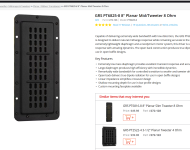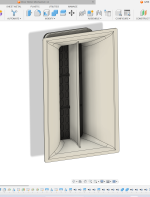A know a lot of you take the measurements from HifiCompass very seriously as he is a 3rd party tester.
I am not understanding his star rating.
Lets take three drivers that are very similar and compare them. I would like you to explain what makes one better than the other.
1, Dayton Aluminum Dome Mid
https://www.parts-express.com/Dayto...nce-Aluminum-Dome-Midrange-285-020?quantity=1
HifiC review 5 stars
https://www.parts-express.com/Dayto...nce-Aluminum-Dome-Midrange-285-020?quantity=1
2. Dayton Fabric Dome mid
https://www.parts-express.com/Dayto...Fabric-Dome-Midrange-8-Ohm-285-022?quantity=1
HifiC review - only 3 stars
https://hificompass.com/en/speakers/measurements/dayton-audio/dayton-audio-rs52fn-8
3. Hivi DMB-A
https://www.parts-express.com/HiVi-DMB-A-2-Fabric-Dome-Midrange-297-716?quantity=1
HifiC Review - back up to 5 stars for this one
I will post up the 3 graphs I think I understand pretty well: the frequency response, the distortion, and the waterfall or spectral decay
Looking at these they look almost the same to me. They might have little variations but not enough to knock one of the three down to 3 starts and give the other two a flying color review.
What am I missing? If anything I'd give the Dayton Aluminum a knock for that giant peak at 12k hz. [/B]
I am not understanding his star rating.
Lets take three drivers that are very similar and compare them. I would like you to explain what makes one better than the other.
1, Dayton Aluminum Dome Mid
https://www.parts-express.com/Dayto...nce-Aluminum-Dome-Midrange-285-020?quantity=1
HifiC review 5 stars
https://www.parts-express.com/Dayto...nce-Aluminum-Dome-Midrange-285-020?quantity=1
2. Dayton Fabric Dome mid
https://www.parts-express.com/Dayto...Fabric-Dome-Midrange-8-Ohm-285-022?quantity=1
HifiC review - only 3 stars
https://hificompass.com/en/speakers/measurements/dayton-audio/dayton-audio-rs52fn-8
3. Hivi DMB-A
https://www.parts-express.com/HiVi-DMB-A-2-Fabric-Dome-Midrange-297-716?quantity=1
HifiC Review - back up to 5 stars for this one
I will post up the 3 graphs I think I understand pretty well: the frequency response, the distortion, and the waterfall or spectral decay
Looking at these they look almost the same to me. They might have little variations but not enough to knock one of the three down to 3 starts and give the other two a flying color review.
What am I missing? If anything I'd give the Dayton Aluminum a knock for that giant peak at 12k hz. [/B]
Attachments
-
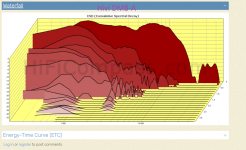 Screenshot 2024-10-20 200141.png759.6 KB · Views: 57
Screenshot 2024-10-20 200141.png759.6 KB · Views: 57 -
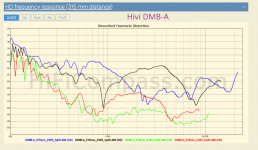 Screenshot 2024-10-20 200107.png466.7 KB · Views: 47
Screenshot 2024-10-20 200107.png466.7 KB · Views: 47 -
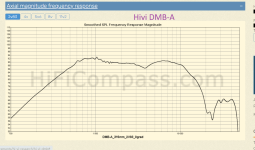 Screenshot 2024-10-20 200028.png390.5 KB · Views: 49
Screenshot 2024-10-20 200028.png390.5 KB · Views: 49 -
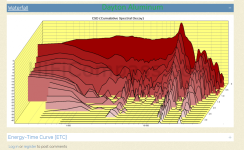 Screenshot 2024-10-20 195945.png859.9 KB · Views: 46
Screenshot 2024-10-20 195945.png859.9 KB · Views: 46 -
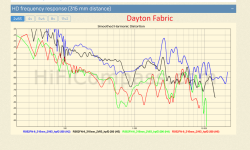 Screenshot 2024-10-20 195749.png612.7 KB · Views: 45
Screenshot 2024-10-20 195749.png612.7 KB · Views: 45 -
 Screenshot 2024-10-20 195832.png553.2 KB · Views: 44
Screenshot 2024-10-20 195832.png553.2 KB · Views: 44 -
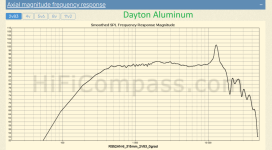 Screenshot 2024-10-20 195910.png365.2 KB · Views: 46
Screenshot 2024-10-20 195910.png365.2 KB · Views: 46 -
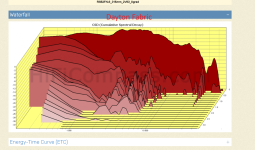 Screenshot 2024-10-20 195649.png893.6 KB · Views: 43
Screenshot 2024-10-20 195649.png893.6 KB · Views: 43 -
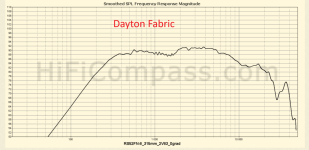 Screenshot 2024-10-20 195551.png292.7 KB · Views: 46
Screenshot 2024-10-20 195551.png292.7 KB · Views: 46
Completely pointless to ponder since the crossover will be 3 to 5K and the peak will be absolutely non existent.What am I missing? If anything I'd give the Dayton Aluminum a knock for that giant peak at 12k hz. [/B]
Having flatter response than all of them.
Countless aluminum drivers have resonance at the tip of there impedance curve from woofers to tweeters.
On crossovers they go bye bye. Then people love to argue it is some issue. But real world
we dont care about off axis, or care about non usable bandwidth at the huge impedance peaks of drivers.
Nobody seems to measure drivers individual on a crossover and also do distortion analysis.
The 2 fabrics have a slight mid dip. Already worked out a crossover for Dayton Fabric.
On a passive crossover with typical impedance correction and series resistance from normal coils.
Frequency response is dead flat. Hardly a issue
White,
Well then this begs another question:
How far padded down does a cone breakup not matter anymore? 15db down? 30? 50?
Ive had XOs up and people lost their minds that I was allowing any amount of cone breakup to cross into the tweeter.
Same thing with tweeter distortion dipping down into the mid. How far padded down does that distortion the tweeter is giving off below 2khz need to be padded for it to become a non issue?
Well then this begs another question:
How far padded down does a cone breakup not matter anymore? 15db down? 30? 50?
Ive had XOs up and people lost their minds that I was allowing any amount of cone breakup to cross into the tweeter.
Same thing with tweeter distortion dipping down into the mid. How far padded down does that distortion the tweeter is giving off below 2khz need to be padded for it to become a non issue?
Many of us didn't have anyone to tell us that because it was little known, not so long ago.. and it didn't bother us as much as thatand people lost their minds that I was allowing any amount of cone breakup to cross into the tweeter.
The real hint all drivers offer is impedance curve.
They rise at both ends and also have a resonant frequency.
Basically hitting resonance down low the the driver is saying hell with you lol
I dont wanna do this anymore.
Also depending on driver size. Once wavelengths are smaller than the cone, directivity develops.
The main game in crossover design, filter it out. Directive frequencies go bye bye hand it over to the next smallest.
Ironically in the upper impedance curve that rises, the speaker is directive anyways.
So we can get a good power response regardless because once it starts rising. The crossover
will be there anyways. So a 8 ohm driver really wont be doing much bandwidth once it starts
going up or down in impedance. most power response will be lower at Re and once rising
to above 8 ohms or so, bloop handed over to the next driver
How far the designers wants to ...stretch that and not use ideal bandwidth is up to them.
With measurements or a correct model, modern software will show you directivity.
Far as tweeters a large 1 1/4" tweeter might have a resonant frequency at 800 Hz or a 1000 Hz
Of course everyone is different that resonance is a good hint where you will find distortion.
And your hoping to be usually twice that at rule of thumb.
So resonance at 800 Hz, crossover min be around 1600 Hz
Using high order filters like 3rd or 4th order will also guarantee less distortion.
Driver basically saying F you I cant do that. Look at my impedance.
High order filter guarantees you are not forcing it to do something it cant.
With smaller tweeters you get up to 1500 to 3000 Hz resonate peaks.
So it instantly tells you. If a 3 inch or 4 inch or 6 inch mid is even realistic.
A tweeter that needs a 4k or higher crossover is gonna be a little mad
if your trying to cross to a 6.5 inch.
Unless of course like many, run the 6,5 inch higher, more distortion.
And run the tweeter high as well. Tradeoff is a huge off axis dip in the response.
They rise at both ends and also have a resonant frequency.
Basically hitting resonance down low the the driver is saying hell with you lol
I dont wanna do this anymore.
Also depending on driver size. Once wavelengths are smaller than the cone, directivity develops.
The main game in crossover design, filter it out. Directive frequencies go bye bye hand it over to the next smallest.
Ironically in the upper impedance curve that rises, the speaker is directive anyways.
So we can get a good power response regardless because once it starts rising. The crossover
will be there anyways. So a 8 ohm driver really wont be doing much bandwidth once it starts
going up or down in impedance. most power response will be lower at Re and once rising
to above 8 ohms or so, bloop handed over to the next driver
How far the designers wants to ...stretch that and not use ideal bandwidth is up to them.
With measurements or a correct model, modern software will show you directivity.
Far as tweeters a large 1 1/4" tweeter might have a resonant frequency at 800 Hz or a 1000 Hz
Of course everyone is different that resonance is a good hint where you will find distortion.
And your hoping to be usually twice that at rule of thumb.
So resonance at 800 Hz, crossover min be around 1600 Hz
Using high order filters like 3rd or 4th order will also guarantee less distortion.
Driver basically saying F you I cant do that. Look at my impedance.
High order filter guarantees you are not forcing it to do something it cant.
With smaller tweeters you get up to 1500 to 3000 Hz resonate peaks.
So it instantly tells you. If a 3 inch or 4 inch or 6 inch mid is even realistic.
A tweeter that needs a 4k or higher crossover is gonna be a little mad
if your trying to cross to a 6.5 inch.
Unless of course like many, run the 6,5 inch higher, more distortion.
And run the tweeter high as well. Tradeoff is a huge off axis dip in the response.
White,
Got it, that makes sense. I will have to start looking at these impendence graphs a little closer.
Got it, that makes sense. I will have to start looking at these impendence graphs a little closer.
Not at all. What if I changed "and it didn't bother us as much as that" to read "and breakup didn't bother us as much as that" 😉Is that some sort of a dig at me?
The underlying message was that sometimes things are blown out of proportion on the interwebz.
Breakup is not related to impedance, it is related to cone size. You can't tell breakup from a response plot, but you can guess it from cone size and you can see it in polar measurements.
This is correct thinking. Try 20dB, give or take.How far padded down does a cone breakup not matter anymore? 15db down? 30? 50?
When shuffling through drivers online.
Tweeters should list Fs
You basically know to be 2x over that.
If a design pushes very close to that 3rd or 4th order is guarantee to stay out of trouble.
With ultra ultra tight center to center, vertical will be the tough guy no matter what.
And in a zillion sims I already seen 4th order the only option to get even close to no issues.
Other than that phase flips up high around 5K will always rip your hair out.
And setback drivers will be the only option or recent testing with all pass.
Why I see 5 or 10 thousand dollar speaker systems. With nonsense center to center spacing.
Assuming non or few are using 4th order. Even then with 4th order....Nope
Vertical is tough and there is endless excuses and made up BS to make excuses for untouchable vertical.
room this, reflection that, image this , image that blah blah blah
Tweeters should list Fs
You basically know to be 2x over that.
If a design pushes very close to that 3rd or 4th order is guarantee to stay out of trouble.
With ultra ultra tight center to center, vertical will be the tough guy no matter what.
And in a zillion sims I already seen 4th order the only option to get even close to no issues.
Other than that phase flips up high around 5K will always rip your hair out.
And setback drivers will be the only option or recent testing with all pass.
Why I see 5 or 10 thousand dollar speaker systems. With nonsense center to center spacing.
Assuming non or few are using 4th order. Even then with 4th order....Nope
Vertical is tough and there is endless excuses and made up BS to make excuses for untouchable vertical.
room this, reflection that, image this , image that blah blah blah
Yes. Yevgeniy provides consistent, comparable measurements for many brands and he also does measurements many others don't do.A know a lot of you take the measurements from HifiCompass very seriously as he is a 3rd party tester.
If I am not mistaken that's his personal, subjective rating. But considering his experience and knowledge I would say it is relevant.I am not understanding his star rating.
The tweeter Fs 2x is good to know. I will use that for sure.When shuffling through drivers online.
Tweeters should list Fs
You basically know to be 2x over that.
If a design pushes very close to that 3rd or 4th order is guarantee to stay out of trouble.
With ultra ultra tight center to center, vertical will be the tough guy no matter what.
And in a zillion sims I already seen 4th order the only option to get even close to no issues.
Other than that phase flips up high around 5K will always rip your hair out.
And setback drivers will be the only option or recent testing with all pass.
Why I see 5 or 10 thousand dollar speaker systems. With nonsense center to center spacing.
Assuming non or few are using 4th order. Even then with 4th order....Nope
Vertical is tough and there is endless excuses and made up BS to make excuses for untouchable vertical.
room this, reflection that, image this , image that blah blah blah
I am not sure I follow about the center to center spacing. I have seen where the distance between drivers can cause big issues with the vertical off axis.
Here is a screenshot example of what I was talking on earlier. The two orange circles highlight cone breakups. They are 20-25 db down so I'm not sure that will be audible. But how far down do they need to be padded so it doesn't matter anymore?
The purple square shows where the planar mid/tweeter leaks into the mid range. I expect this to be audible as it is only 10 db down from where the main mid is playing.
Fyi: this is all theoretical traced data though I did put in theoretical spacing between the drivers
Attachments
Re: hfc ratings/marks, this may help:
"Measurements" are just "dry" measurements, no more.
HiFiCompass "mark" is my personal subjective rating of a specific speaker driver. It takes in account the following factors:
- objective technical measurements
- subjective listening impressions
- applicability
- the price
- any others, which have much less weight
There is no a precise formula connecting all these factors. A speaker may be very simple and cheap, has ordinary measurements but at the same time have quite good sound and incredible perfomance/price ratio. I applaud the manufacturer - 5 stars:
Vifa OC25SC65-04 | HiFiCompass
Another case, there is a much better sounding and technically more impressive speaker, but having a technical flaw (resonance at 8.5 kHz), which is unacceptable for its price. So, just 4 stars:
Accuton BD25-6-258 | HiFiCompass
Motokok,
This answers my question. I thought maybe he gave them a listen and based it off of that but I found nowhere posted that that was, in fact, true.
Thank you
This answers my question. I thought maybe he gave them a listen and based it off of that but I found nowhere posted that that was, in fact, true.
Thank you
Hey guys, please don't take my star rating too personally. This rating is quite subjective and may change over the years because my personal experience changes as well. Right now, I feel that a 5 star rating does not allow me to adequately judge the value of the speakers because in the 7 years since the site was launched, the world has seen many good speakers that deserve more than 5 stars compared to the top speakers before 2017. I apologize for the inconvenience, if all goes well I plan to expand the 5 star rating and revise my evaluations in the future.
Yevgeniy
Yevgeniy
Who knows, maybe it will get 20 points or 30 points... of 100🙂
Ragged response, high distortion, very high price, nice warm comfortable sound - nothing more. Nevertheless, I like it and made loudspeakers with it and the 27TDFC.
Ragged response, high distortion, very high price, nice warm comfortable sound - nothing more. Nevertheless, I like it and made loudspeakers with it and the 27TDFC.
Right -and that's more or less the point. Peter Comeau specifically commissioned the H1411 from Seas (went over there to their archives) as a 'nearest they could manage with current components' to the old bass unit they designed & built for Dynaco back in the '70s. If you want 'sound of the era' without buying vintage drivers, it's a good place to start.
Most definitely center-to-center spacing between midrange and tweeter units will affect the vertical radiation pattern. In addition, some crossover topologies are much more sensitive to this parameter than others. As one goes above or below the design axis, additional differences in the distances from the drivers to the listening point will be introduced. At frequencies such as 3kHz, where the wavelength of sound is about 11.4 cm, all it takes is a difference in distance of 5.7cm to get strong cancellation effects coming into play (if the drivers have outputs that are similar in amplitude).I am not sure I follow about the center to center spacing. I have seen where the distance between drivers can cause big issues with the vertical off axis.
I would expect that 20dB would be the minimum amount of attenuation of major resonances that one should aim for. This is particularly important for high-Q resonances, as these can ring for quite a few cycles after the excitation signal is removed.Here is a screenshot example of what I was talking on earlier. The two orange circles highlight cone breakups. They are 20–25 dB down so I'm not sure that will be audible. But how far down do they need to be padded so it doesn't matter anymore?
I am not sure of any publications that have reported on the audibility of such high-Q resonances hidden under the main response signal. Maybe someone can chime in and mention such publications if they know of any that may be out there?
Being only 10dB down, that wide plateau in the tweeter's response is certainly a bit of a worry. I am not sure how it will sound, but it will certainly detract from achieving a point-source sound radiation system at midrange frequencies in the region where the overlap is occurring. This could result in: a) making the sound source appear to be larger, and b) adding some unusual spatial effects to recordings.The purple square shows where the planar mid/tweeter leaks into the mid range. I expect this to be audible as it is only 10 dB down from where the main mid is playing.
I'd hazard a guess that the crossover network needs to be revisited and modified to achieve a much more conventional blending of the midrange and tweeter outputs. That is a much safer option.
If its not too forward of me, let me make a couple suggestions:Hey guys, please don't take my star rating too personally. This rating is quite subjective and may change over the years because my personal experience changes as well. Right now, I feel that a 5 star rating does not allow me to adequately judge the value of the speakers because in the 7 years since the site was launched, the world has seen many good speakers that deserve more than 5 stars compared to the top speakers before 2017. I apologize for the inconvenience, if all goes well I plan to expand the 5 star rating and revise my evaluations in the future.
Yevgeniy
A 10 star rating system for overall.
A breakdown of 5 star ratings, one for each of the following categories
1. Subjective listening experience
2. Performance overall
3. Performance to price
5. Useability
I feel like this wouldn't take much more time but it would portray your findings in a more expansive matter. I think you taking the time to record all of these findings means you definitely do care about sharing with others.
I'd also like to just take a second and say thank you for taking the time to share. Most people wouldn't take the time. I very much appreciate your site.
Witwald,
This is much clearer now. Thank you for explaining further.
I did notice the different order crossovers interplay with the distances. This is why I like to play around with traced data before I ever buy anything. Takes me a month or so.
That crossover I showed actually uses a planar midrange/tweeter. That mid range should be playing quite clean. I am going to buy those and mess around with them. I think I can physically horn them and enclose the back to make them behave a bit better. I also need to figure out where they play clean and where they don't. Too much of an experiment to order anything else with it. Here is V1 of the planar mid horn. I will post up with data when I have it.
They have a smaller 4.5 tweeter version that looks really neat. I was thinking of using that with a dome mid and then pairing it with a sub for a desktop near field 3 way. I haven't quite figured it all out yet to be honest.
This is much clearer now. Thank you for explaining further.
I did notice the different order crossovers interplay with the distances. This is why I like to play around with traced data before I ever buy anything. Takes me a month or so.
That crossover I showed actually uses a planar midrange/tweeter. That mid range should be playing quite clean. I am going to buy those and mess around with them. I think I can physically horn them and enclose the back to make them behave a bit better. I also need to figure out where they play clean and where they don't. Too much of an experiment to order anything else with it. Here is V1 of the planar mid horn. I will post up with data when I have it.
They have a smaller 4.5 tweeter version that looks really neat. I was thinking of using that with a dome mid and then pairing it with a sub for a desktop near field 3 way. I haven't quite figured it all out yet to be honest.
Attachments
- Home
- Loudspeakers
- Multi-Way
- Reading graphs help - breaking down Hificompass measurements

